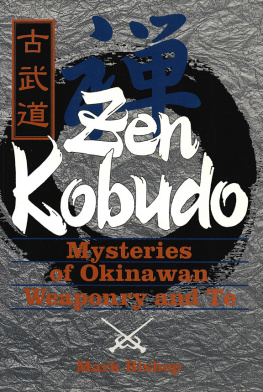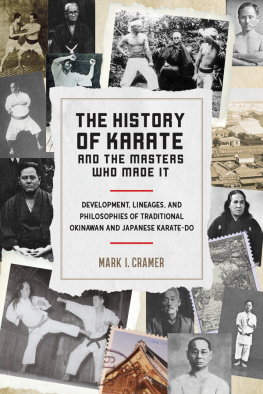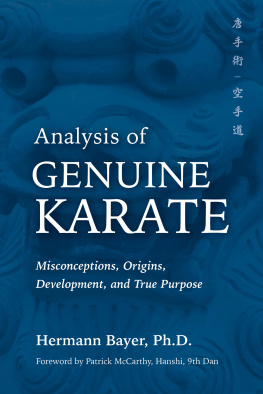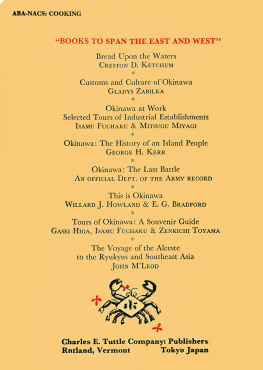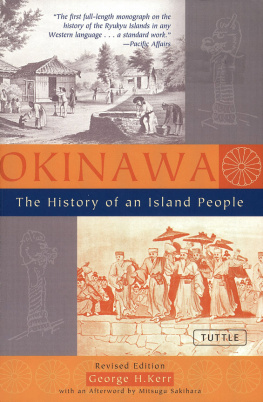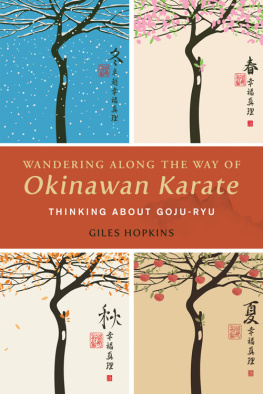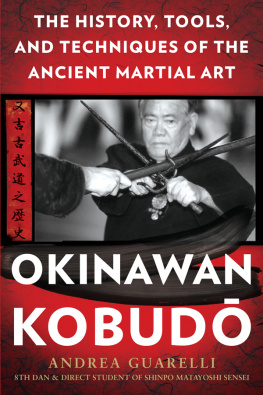Mark D. Bishop - Zen Kobudo: Mysteries Of Okinawan Weaponry And Te
Here you can read online Mark D. Bishop - Zen Kobudo: Mysteries Of Okinawan Weaponry And Te full text of the book (entire story) in english for free. Download pdf and epub, get meaning, cover and reviews about this ebook. year: 1996, publisher: Tuttle Publishing, genre: Religion. Description of the work, (preface) as well as reviews are available. Best literature library LitArk.com created for fans of good reading and offers a wide selection of genres:
Romance novel
Science fiction
Adventure
Detective
Science
History
Home and family
Prose
Art
Politics
Computer
Non-fiction
Religion
Business
Children
Humor
Choose a favorite category and find really read worthwhile books. Enjoy immersion in the world of imagination, feel the emotions of the characters or learn something new for yourself, make an fascinating discovery.
- Book:Zen Kobudo: Mysteries Of Okinawan Weaponry And Te
- Author:
- Publisher:Tuttle Publishing
- Genre:
- Year:1996
- Rating:4 / 5
- Favourites:Add to favourites
- Your mark:
- 80
- 1
- 2
- 3
- 4
- 5
Zen Kobudo: Mysteries Of Okinawan Weaponry And Te: summary, description and annotation
We offer to read an annotation, description, summary or preface (depends on what the author of the book "Zen Kobudo: Mysteries Of Okinawan Weaponry And Te" wrote himself). If you haven't found the necessary information about the book — write in the comments, we will try to find it.
Zen Kobudo: Mysteries Of Okinawan Weaponry And Te — read online for free the complete book (whole text) full work
Below is the text of the book, divided by pages. System saving the place of the last page read, allows you to conveniently read the book "Zen Kobudo: Mysteries Of Okinawan Weaponry And Te" online for free, without having to search again every time where you left off. Put a bookmark, and you can go to the page where you finished reading at any time.
Font size:
Interval:
Bookmark:
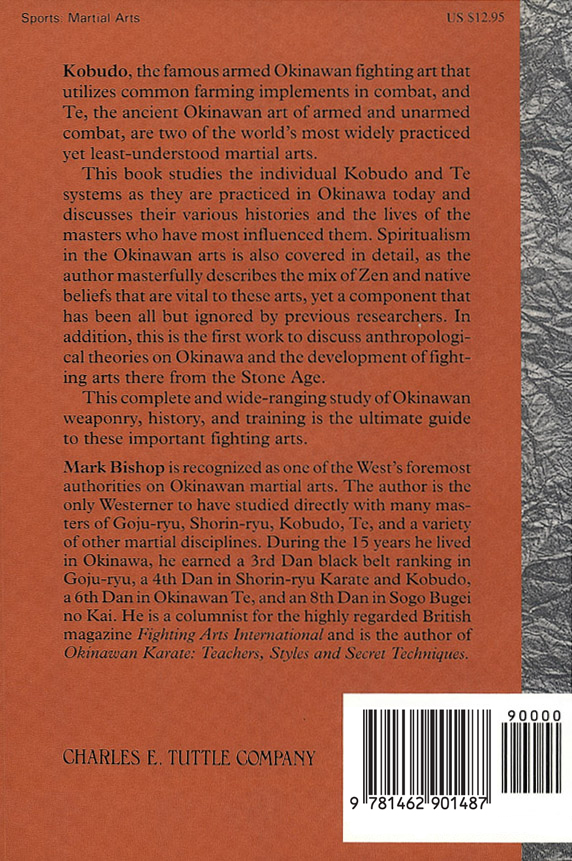

Appleman, Roy E., James M. Burns, Russell A. Gugeler, John Stevens. Okinawa: The Last Battle. Tokyo: Charles E. Tuttle Co., 1960.
Bishop, Mark. Okinawan Karate, Teachers, Styles and Secret Techniques. London: A & C Black, 1989.
Draeger, Donn F. and Robert W. Smith. Asian Fighting Arts. Tokyo: Kodansha International Ltd., 1969.
Frank, Benis M. Okinawa: Touchstone to Victory. U.S.A.: MacDonald & Co. Ltd., 1969.
Hanayama, Shinsho and D. Litt. A History of Japanese Buddhism. Tokyo: Bukkyo Dendo Kyokai, 1960.
Haring, Douglas G. Okinawan Customs, Yesterday and Today. Tokyo: Charles E. Tuttle Co., 1969.
Kerr, George H. Okinawa, The History of an Island People. Tokyo: Charles E. Tuttle Co., 1958.
McFairland, Neill H. Daruma: The Founder of Zen in Japanese Art and Popular Culture. Tokyo: Kodansha International, 1987.
Miyazato, Eiichi. Okinawa Goju-ryu Karate-do. Tokyo: Jitsugyo no Sekai Sha, 1978.
Murakami, Katsumi. Karate-do to Ryukyu Kobudo. Tokyo: Seibido Sports Library, 1977.
Nagamine, Shoshin. Okinawa no Karate-do: Rekishi to Densetsu o Mamoru. Tokyo: Shinjinbutsu Oraisha, 1975
Nagamine, Shoshin. The Essence of Okinawan Karate-do. Tokyo: Charles E. Tuttle Co., 1976.
Ono, Keihan. Kenpu Shukuya: Dai Ichi Bu. Tokyo: Nihon Taido Kyokai, 1972.
Oechsle, Rob. Aoi Me ga Mita Dai Ryukyu: Great Ryukyu Discovered19th Century Ryukyu in Western Art and Illustration. Okinawa: Nirai-sha, 1987.
Reischauer, August Karl. The Nature and Truth of the Great Religions. Tokyo: Charles E. Tuttle Co., 1966.
Robinson, James. Okinawa, A People and Their Gods. Tokyo: Charles E. Tuttle Co., 1969.
Smith, Robert W. Secrets of Shaolin Temple Boxing. Tokyo: Charles E. Tuttle Co., 1964.
Smith, Robert W. Pa-kua: Chinese Boxing for Fitness and Self-Defense. Tokyo: Kodansha International Ltd., 1967.
Smith, Robert W. Hsing-i, Chinese Mind-Body Boxing. Tokyo: Kodansha International Ltd., 1974.
Smith, Robert W. Chinese Boxing: Masters and Methods. Tokyo: Kodansha International Ltd., 1974.
Taira, Shinken. Ryukyu Kobudo Taikan: Hozon Ryukyu Kobudo Shinko- kai, Okinawa: published privately, 1964.
Uechi, Kanyei. Seisetsu Okinawa Karate-do: Sono Rekishi to Giho. Okinawa: published privately, 1978.
Yamanouchi, Seihin. Dance of Ryukyu and Self-Defense Dances. Tokyo: published privately, 1963.

Weapons, as will be seen, have been used on Okinawa, as in most cultures, since before the dawn of history, when primitive Stone Age implements were employed to murder people instead of for hunting animals. The techniques for these have been lost, but what is unique about the Okinawan heritage is that the later introduced refined and stylized weapons systems and strategies have been handed down for over a thousand years, almost intact with few alterations, to the present generations.
The weapons used in Te and Kobudo range in shape and substance from the deadly macabre to the seemingly ineffective; from the swift and silent projectile bow and arrow to the innocent-looking wooden agricultural flail and from the sinister curved sword to the effeminate, yet effective (in trained hands), bamboo and silk fan. In all, fifty hand-held weapons have been recorded, which are generally sorted into twenty-one different types, namely: bow and arrow; sword; glaive (sometimes called a halberd); hand spear; sharp implement with shield; sickle; hoe; three-pronged truncheon; weight and chain; knuckle-duster; metal rod; staff; stick; oar; flail; right-angle handle truncheon; umbrella; fan; hairpin; other accessories (which includes tobacco pipes, musical plectrums, and dried beans); and firearms. Although these types of weapons have never been systematically categorized in writing before, I thought it appropriate to break with convention and list them in some kind of ordered classification for inclusion in the following index and for their further detailed study.
Before a final decision was made on what categories to use, several loosely defined concepts were carefully looked at. These included the more obviously popular, dual designation of "agricultural-based weapons" as opposed to "non-agricultural-based weapons" and the contrasting of "Te-based weapons" to "Chinese-based Kobudo weapons." However, although these general groupings are frequently resorted to verbally by many Kobudo and Te teachers on Okinawa, they are neither clear-cut nor comprehensive enough for use in this book. In this respect, there is no real distinct difference between what is, or is not, an agricultural-based weaponthe definition of such being purely subjective. No one can define with authority what constitutes a Te-based weapon, or a Chinese-based Kobudo one either; for although the weapon may be the same, its techniques during practice will be quite different in the two systems.
Historically speaking, for example, Te was concerned mostly with metal-bladed weaponry, however the blunt wooden oar has remained a part of the Te repertoire since time immemorial, adapting of late Kobudo techniques and forms as well. Therefore, after much careful deliberation, a sensible, non-partisan weapon classification, based more on simple convenience rather than anything else, was decided upon. This categorizes them as either "metal," "wooden," or "other weapons." The first category is farther divided into two subdivisions each namely: "bladed metal weapons," which include bow and arrow, sword, knife, glaive, hand spear, and sickle, and "non-bladed metal weapons" such as the three-pronged truncheon with its variations and the knuckle-duster. "Wooden weapons" include the staff, flail, and right-angle handle truncheon, whereas "other weapons" are the less familiar implements or weapons, such as the paper umbrella, fan, and the Okinawan hairpin, in addition to the other accessories and firearms mentioned earlier.
However, these groupings are not clear-cut either, because few of the weapons are actually all wood or all metal, most being composed, to varying extents, of both materials. Whereas the three-pronged truncheon is made entirely of iron, steel, or bronze, the sword, with its all-steel blade, will have a partly wooden hilt, while the glaive has a long, wooden handle with a metal cutting, or slicing, edge on the end. In this way, the bow and arrow, which is mostly a wooden weapon, is listed in the "bladed metal weapons" category, because it has a metal cutting edge at its lethal end in the form of the arrowhead.
What is meant by "non-bladed metal weapons" is any weapon without a cutting, slicing, or stabbing edge for piercing human flesh. The wooden weapons usually contain no metal at all, whereas those listed under "other weapons," may be constructed of either wood or metal, or be composite. The latter have been listed as such, more for their general unfamiliarity, or strangeness, rather than for anything else. All the recorded weapons, except for those listed under the titles bow and arrow, other accessories, and firearms, are still taught as a part of the Te or Kobudo systems, in a safe manner, by highly skilled and responsible masters at their respective schools.
Metal Weapons (Bladed)
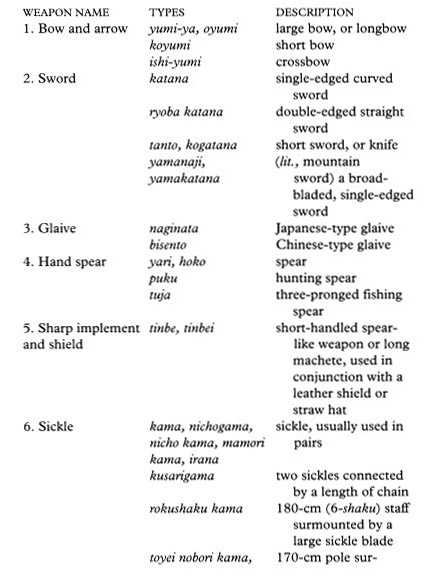
Font size:
Interval:
Bookmark:
Similar books «Zen Kobudo: Mysteries Of Okinawan Weaponry And Te»
Look at similar books to Zen Kobudo: Mysteries Of Okinawan Weaponry And Te. We have selected literature similar in name and meaning in the hope of providing readers with more options to find new, interesting, not yet read works.
Discussion, reviews of the book Zen Kobudo: Mysteries Of Okinawan Weaponry And Te and just readers' own opinions. Leave your comments, write what you think about the work, its meaning or the main characters. Specify what exactly you liked and what you didn't like, and why you think so.

